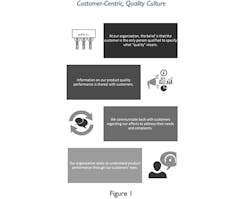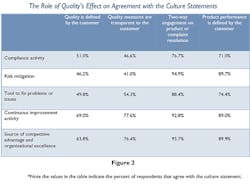It is clear that many organizations are becoming true partners with their customers in order to maximize the value for both stakeholders. Organizations’ definition of quality, the actual quality processes, and using quality measures to drive performance and culture are all closely tied to customers. Because quality and customers are so closely aligned in successful organizations, the two concepts are intersecting into a customer-centric quality culture.
While manufacturing organizations tend to use mature quality practices—in regards to governance models, availability and use of metrics, quality management frameworks and certifications, and training—do their practices include a focus on the customer? What defines a customer-centric, quality culture and what are the driving factors of its success?
To answer these questions APQC conducted correlation analysis on data, specifically for the manufacturing industries, from ASQ’s The Global Sate of Quality survey conducted by APQC for ASQ. The customer-centric quality culture can be defined by four statements that elucidate the organization’s relationship with its customer around quality (Figure 1).
Most of the survey respondents indicated they agree with the statements. However all cultural attributes were not weighted equally. The emphasis was placed on customer service and product performance, rather than two-way engagement or quality and what it means to the customer.
When looking at what drives the intersection of customer and quality, the analysis found four key factors:
- The role of quality within the organization.
- Integration of goals in strategic planning.
- Level of transparency on quality goals and reporting.
- How the quality measures are used.
The Role of Quality
As organizations evolve quality from merely being a ‘checking the compliance boxes’ to really using quality practices to impact and empower staff to make improvements and address customer needs, there is opportunity for a greater return on investment and improved customer satisfaction. Organizations that use quality as a source of competitive advantage, operational excellence, or as a continuous improvement activity are much more likely to embrace the customer-centric, quality culture (Figure 2).
For example organizations that use quality as a source of competitive advantage are more likely to make their quality measures transparent to their customers (76.4%) than those who use it as a compliance activity (46.6%). This is particularly true for understanding what defines culture from the customer’s perspective.
Integration in Strategic Planning
To understand what’s truly valuable to the organization, one has to look at what makes it into the strategic plan. Although there is always intrinsic value in the use of quality goals and measures within an organization, it is when these goals are established across the organization—corporate, management and support services, and operational businesses and functional units—that quality can have the greatest impact on overall performance.
Level of Transparency
Transparency on quality measures helps create buy-in on quality management and enables employees to understand what role quality plays in how they do work, how they can impact quality, and its effects on their customers’ satisfaction. Transparency breeds accountability at the most basic level and even drives a healthy competition between business units. It also tends to increase knowledge-sharing opportunities (e.g., best practices or lessons learned), as managers with lower performance often reach out to managers in groups with higher performance, even across diverse products and services within the same organization.
Use of Quality Measures
The majority of respondents use quality measures to set goals that will drive higher performance throughout the organization (76%), for predictive analysis to identify potential opportunities or issues in their operations and business process (66%), and as part of their variable-performance compensations (61%). However organizations that include quality measures to drive higher performance or for operational improvement are more likely to agree with the customer-centric, quality cultural statements. This adoption indicates that the organization has embraced the quality culture and it’s simply now how they do business.
Holly Lyke-Ho-Gland is a research specialist, business excellence with APQC, a member-based nonprofit and one of the leading proponents of benchmarking and best practice business research. Working with more than 500 organizations worldwide in all industries, APQC focuses on providing organizations with the information they need to work smarter, faster, and with confidence.






